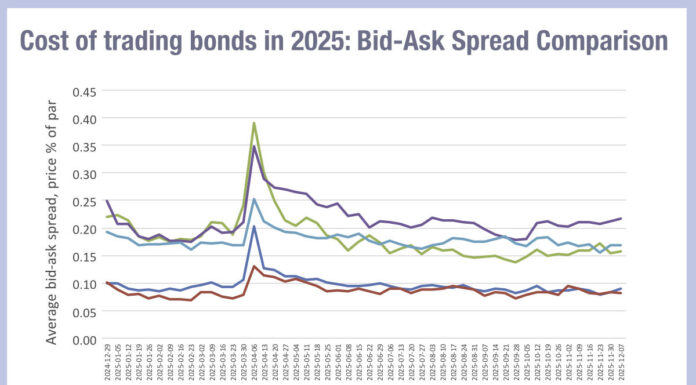Gherardo Lenti Capoduri, head of Banca IMI’s Market Hub, speaks with The DESK about the capacity of firms on both sides of the street to manage the risks created by MiFID II.

Which buy-side firms should be most concerned by MiFID II?
I think that the smaller buy-side firms should be most concerned by MiFID II adoption, although even among larger buy-side firms, which are likely to be at the most advanced stage of preparation, the launch of MiFID II could still cause disruption.
Main concerns will be with regard to:
• increasing costs due to technological implementation, data mining and new internal processes and controls to be established;
• risk of failure to provision or invest enough budget for new regulatory changes – for those who did it was often too little, and in some cases too late.
Recent surveys estimate a cost of E2.5 billion across the industry to meet the regulatory requirements; this equates to an average of E10.3 million for the top tier companies at a time when revenues from trading activity are shrinking and a big effort to create efficiency is required.
What elements of the rules pose the greatest risk on day one?
MiFID II has an ambitious and mostly shared long-term target, that is, to promote investor protection and transparency but with a broader scope than in MiFID I. However, in the short term, on the eve of January 3rd 2018, going into the new MiFID II era, we expect firms to have considerable uncertainty over whether or not they will be compliant with the new regulation, and as a consequence of that we expect there to be a bit of anxiety among all market players, which might impact liquidity and turnover in the following weeks.
This will be because the industry is not fully compliant with the new regulatory regime, in particular certain technological implementations. Some ambiguities over specific interpretations of the rules are still to be resolved, data are incomplete and a lot of assumptions made previously in the strategic approach to MiFID II have to be processed via real market practice. Most market players seem to be making strategic or tactical decisions already, but they will need time to fit everything in. Going into greater depth on the real effects on trading activity: among the rules that might pose the greatest risk on Day 1, I’d definitely focus on research unbundling, the new transparency regime and its potential impact on market liquidity, and trading obligations on equity cash and derivatives.
Has Italy’s engagement with fixed income under MiFID I reduced the impact of MiFID II on investment firms?
In the Summer of 2017, the Italian parliament passed a bill which updates and amends the Italian Financial Act to reflect the main provisions of MiFID II, while Consob, the Italian financial market regulator, launched a consultation in relation to the second-level regulatory measures aimed at updating the Italian regulatory framework to reflect MiFID II’s level 2 measures.
These interventions helped the Italian market have a clearer picture of how MiFID II would be implemented and its impact on day-to-day business. With regards to fixed income markets in Italy, the retail component is still very strong and since 2007 Italian regulators extended MiFID I transparency and investor protection rules into this asset class in order to avoid the potential effects of a new financial crisis. For this reason, Italian fixed income market infrastructure is already composed of regulated markets, multilateral trading facilities (MTFs) and systematic internalisers (SIs), and financial players are already used to trading in a more transparent marketplace with different electronic trading protocols.
We could say, in terms of market practice, that the impact of MiFID might be lighter in Italy than elsewhere. Nevertheless, we cannot state that the impact of the new technical standards of MiFID II and MiFIR will not be disruptive, in particular for the smaller firms. In Italy, the reform was targeted at retail business. In 2018, the main scope is trying to ‘manage’ over-the-counter (OTC) institutional business.
How do you expect Europe’s liquidity profile to change after 3 January 2018?
In recent years, secondary market liquidity has been hurt by the financial crisis, ECB monetary policy and the new capital requirements rules. MiFID II is introducing a new market infrastructure: more transparency obligations, new trading venues, more internal processing controls and new trading obligations.
Introducing of all these new rules together, with the initial lack of information and market data, and the uncertainty over technological implementation will have a disruptive effect at the beginning, in particular on fixed income market, and mainly OTC and voice-driven trading. We might expect anyway that (i) the new transparency regime, (ii) new players getting in the market arena, (iii) a wider adoption of the new vendor solutions together with (iv) a different relationship model between the sell side and the buy side, with the buy side having a greater role in the market as price-maker and not only price taker, will help, little by little, to reduce the cost of trading and to improve secondary market liquidity.
Do you expect the cost of liquidity to increase?
A scenario where the cost of the liquidity in the secondary market is increasing will have a negative effect on the primary market itself and consequently on the cost of funding for industrial and financial corporates. In the transition to the new regime, we expect the cost of liquidity to go up, mainly in the secondary corporate bond market for more illiquid instruments and large size orders. The risk of an increase will be much higher when looking at the depth of liquidity over the breadth of liquidity. This is due to the uncertainty over the new business models and regulatory changes, to a shortfall in the market making-centric model and to the slow implementation of new technological solutions and execution protocols.
Liquidity fragmentation will lead to a reduction in ticket sizes, but later on to a process of concentration in a few successful and efficient solutions. In this environment, the role of transaction cost analysis (TCA), which has been correctly adopted in forex and equity markets but less in fixed income, might be crucial for buy-side clients as well as for brokers and intermediaries.
How will the use of electronic trading change?
I think electronic trading might well increase and become more efficient. The incoming regulations designed to make markets more transparent might erode voice-trading volumes in fixed income. Under MiFID II rules, market participants in the European Union will have to report a host of information for transparency and transaction reporting rules, and in order to demonstrate that they are executing clients’ trades at the best prices and on the right venues. Tracking those details is faster and cheaper when the trades are electronically executed, rather than by shouting down the phone.
Voice trading will be focused in those scenarios and value added products where it truly remains the most efficient way of finding and matching counterparty interest at a reasonable cost e.g. block orders on illiquid financial instruments. While trading by phone or in person won’t vanish, it will diminish. This will probably be accompanied by a rebalancing of the principal-to-principal model towards more of an agency model that fits better with an electronic execution approach. For investment firms, one of the biggest challenges will be setting up systems to move from a voice-driven trading environment to one that’s increasingly digitised to meet MiFID II’s data reporting requirements. A number of financial technology companies have popped up to assist banks, brokers and asset managers conform to the new standards, processed / negotiated trade models, as well as sale-to-trader electronic tools, among others.
Where can investment banks best support their clients to achieve the best outcome in the transition to the new regulatory regime?
First of all, I want to highlight that in 2018 we shall assist in a real Copernican revolution in European financial markets, with a disruptive impact on business models and human behaviour itself. For this reason, sell side, buy side, trading venues, vendors and regulators have to take important strategic decisions on ‘what we are or shall be’, work together to build the new financial market infrastructure as requested by MiFID II/MiFIR, and then adapt themselves to it. Market players have to face a completely new financial market landscape and 3rd January 2018 probably marks more a start than an end to this evolution process
In particular, in the transition to the new regime, the complexity of the new financial landscape, access to fragmented market liquidity, the data mining for TCA, best execution and reporting, and the expensive technological innovations are the main challenges that the buy side has to face in the near future. In this new environment, and to better support their clients to achieve best outcomes, investment banks have to re-think their business model, towards a model that is more customer-oriented and with a more efficient execution process.
Today, fixed income is still mainly a high-touch, risk-principal model. We might assist in a rebalancing towards a more low-touch, risk-averse, agency model approach, which might provide an array of compliant customer services and better support the traditional risk-principal model with a more efficient sourcing of liquidity. The big challenge for the sell side will be the way in which the traditional, OTC voice, fixed income market model will change in terms of high touch and low touch trading.
©Markets Media Europe 2025












